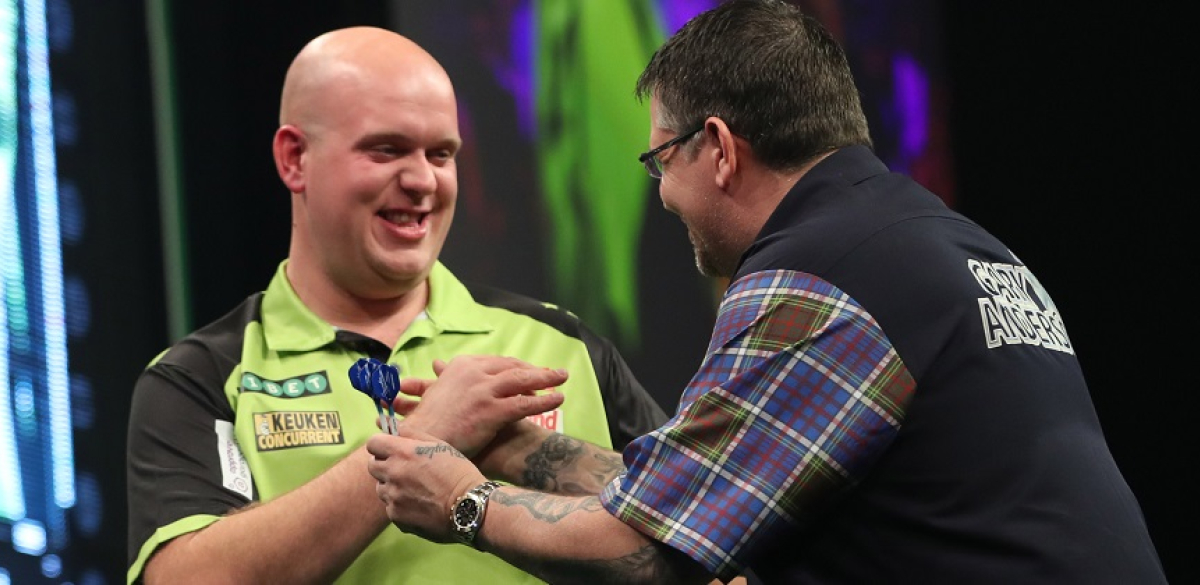
Christopher Kempf, the statistical analyst of the PDC, takes a look at the probabilities of darts' biggest single-leg achievements, the nine-darter and 170 finish.
THE fifth leg of the recent Unibet Premier League match between Gary Anderson and Michael van Gerwen was a special treat for darts fans, a superlative display of skill from two titans of the game.
The odds are against our seeing the combination of seven perfect darts from one player and a 170 finish to punish the inaccuracy of the other in our lifetimes, but with both players among an elite group of players who frequently average 110+, we have good reason to hope for a reprise.
Rare events are by their nature difficult to predict, and few events are more rare in darts than the perfect nine-dart leg of 501.
In its most basic form, a nine-darter can be estimated by calculating the likelihood of a player throwing two 180s and a 141 finish in the same leg, and once the probabilities of each individual event are known, we can arrive at a rough estimate of the overall probability of a perfect leg.
The average PDC player, who has about an 8% probability of scoring 180 points with three darts aimed at the treble 20 bed, and a 3% probability of successfully completing a 141 checkout, should expect to hit a nine-dart leg once every 5,000 legs.
The prevalence of perfect legs over the past two months has even surpassed this rate: eight have been recorded in about 28,000 legs of floor and stage play so far this year, representing one nine-darter for every 3,500 legs played.

But shouldn't we expect nine-darters to be far more common?
With the world's top players hitting 180s at a rate often approaching 20% and taking out big finishes with similar regularity, why were only two of the last 20,000 legs played on TV or on the European Tour won in nine darts?
Certainly the noise and expectation emanating from the crowd is an important factor in the best players' nerves.
The same Michael van Gerwen who threw two nine-dart legs in a 2017 ProTour match - at a rate of one for every four legs played, the highest ever recorded - has endured a two-year, 3,000-leg long drought of abortive nine-dart attempts in front of cheering fans.
The disappointment occasioned by missing the ninth perfect dart, the double, has had a severe effect on a player's accuracy with subsequent darts.
Since the beginning of 2018, players who have attempted a double for a nine-darter had the remarkably low doubles percentage of 22% in the leg as they sought to achieve perfection, or failing that to simply be assured of winning the leg.

Two of the last three nine-dart doubles missed on television - Paul Lim's and Phil Taylor's attempts at the World Championship - resulted in a combined nine further missed doubles and in losing the leg, with only Gerwyn Price at the UK Open, two visits later, going on to land a double.
Furthermore, players may be inclined to attempt a more difficult checkout in view of the cameras.
Because a 180 provokes such a boisterous reaction both from the crowd and from the referee calling the match, many players will attempt to hit as many T20s as possible en route to a finish, eschewing the T19 and T18 beds and possible visits of 177 and 174.
About three-quarters of all scores left after hitting six perfect darts were 141, with the majority of the remainder being 144.
Over the span of 12,103 legs played in 2017, PDC players finished 141 in three darts 2.98% of the time, representing one successful finish for every 34 attempts.
Though far fewer 144 checkouts were attempted last year, there were actually more successful finishes, yielding a checkout rate of 6.33%.
The switching back and forth to different extremes of the dartboard necessitated by the most common route to a 141 finish (treble 20, treble 19, double 12) make the 144 finish (treble 20, treble 20, double 12) look simple by comparison.
By throwing a 177 - which, incidentally, is a more common visit relative to a 139 than 180 is to a 140 - in one of the first two visits, a player sets up a finish which is much less technically demanding.
In lieu of the nine-dart Holy Grail, the 170 finish serves well enough as a sumptuous appetizer, as it is attempted, on average, about once every fifteen legs and fans can expect to see one completed, or at least missed on the bullseye, on a regular basis in televised darts.
The 170 checkout may be known as "the big fish", but in fact it is not the most difficult checkout for a player to attempt, and in fact has a similar completion rate to the 141 of about 3%.
167 has the lowest checkout rate of any three-dart finish - fewer than one checkout for every 50 attempts - owing to the need to switch targets with every dart, the absence of alternate routes (only treble 20, treble 19, bullseye is possible) and the required throw for the bullseye to complete the finish.

But the bullseye is hardly an obstacle any more?
The stunning rise in proficiency on the bullseye across the PDC, evidenced by some stunning exhibition shots in floor events that make use of the dartboard's smallest target, has witnessed the top PDC players hitting the bullseye at a rate approaching 35%.
Given the continued stagnation in improvement on the traditional routes to the nine darter, many players might consider that 170 and even 150 (three bullseyes) are becoming improbable, but plausible, routes to a perfect leg.
The prospect of witnessing such a feat in our lifetimes makes the nine dart attempt/170 finish combination seem insignificant by comparison and makes one wonder what worlds will be left to conquer afterwards.